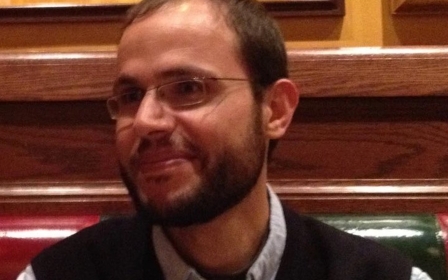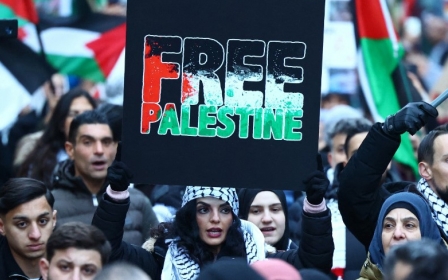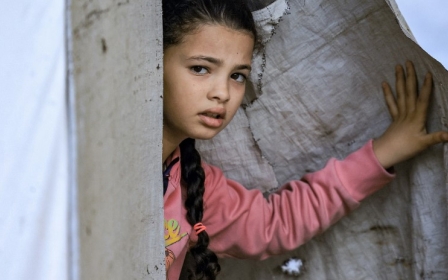Israel-Palestine war: Khan Younis emerges as latest Israel-Hamas front line in Gaza
Khan Younis, originally part of the designated "safe" areas of southern Gaza, has become one of the main battlegrounds in the current Israel-Palestine war.
As the temporary truce came to an end last week, the city's residents received leaflets from the Israeli army telling them to leave the city as it was about to become Israel's next target.
Throughout the first weeks of the war, Khan Younis's population drastically increased as displaced people escaped fighting in Gaza City and the rest of the north.
With very few places remaining for people to flee to, Palestinians are finding themselves caught in some of the most intense fighting seen since the beginning of the war that broke out on 7 October.
Israel claims Hamas leaders are hiding in Khan Younis and has been repeatedly bombing the city while expanding its ground incursion there, killing countless Palestinians and overwhelming local hospitals.
New MEE newsletter: Jerusalem Dispatch
Sign up to get the latest insights and analysis on Israel-Palestine, alongside Turkey Unpacked and other MEE newsletters
Khan Younis is the second-largest city in the Gaza Strip after Gaza City.
The city dates to the Mamluk empire in the 14th century, when Emir Yunus al-Nuruzi constructed a caravanserai, or a "khan" in Arabic, which was a roadside inn where travellers could rest from their day's journey. Hence, the name of the future city became known as Khan Younis.
In 1387, Mamuk Sultan Barqouq ordered the emir to build a castle in his name. The castle not only protected residents of the city but served as a linking point between Cairo and Damascus, as it ensured a space for merchants and travellers to trade. Barqouq Castle stands today as one of the most important historical monuments in Palestine.
Follow Middle East Eye's live coverage for the latest on the Israel-Palestine war
The city, along with the rest of the modern-day Gaza Strip, came under Ottoman rule when the latter defeated the Mamluks in the 16th century as part of the campaign to take over the Sinai Peninsula.
Following the First World War and the defeat of the Ottoman Empire, Palestine came under British rule. Khan Younis, along with the cities surrounding it, became a place of refuge for those escaping Nazi invasions in the Second World War.
"Gaza, along with its cities, hosted Greek people in 1942 after the Nazi attacks on Greece," historian Osama al-Ashqar told Middle East Eye. "British fishing boats and ships transported them from the Greek islands to the coasts of Syria, Palestine and Turkey, and Greek families disembarked in Gaza, Nuseirat and Khan Younis."
'A city under occupation'
After the establishment of the state of Israel in historic Palestine following the war of 1948, more than 750,000 Palestinians were displaced in an event known as the Nakba, or "catastrophe" in Arabic.
Khan Younis became part of Egypt's administration of the Gaza Strip. Armed Palestinian factions, known as fedayeen, operated in the city.
The population also increased, as Palestinian refugees escaping the war settled in the city and its surroundings. According to Ashqar, many of the residents originate from depopulated Palestinian cities and villages from outside the Gaza Strip.
The city and its nearby refugee camp bore the brunt of Israeli military violence during the British-French-Israeli war against Egypt's nationalisation of the Suez Canal in 1956. The Khan Younis massacre saw the Israeli army shoot and kill at least 275 Palestinians, according to UN estimates, but Palestinian sources believe the number to be higher.
Khan Younis came under complete Israeli occupation following the 1967 Middle East War, which saw Israel occupy the Gaza Strip, the West Bank, the Sinai Peninsula from Egypt, and the Golan Heights from Syria.
The city's Palestinian fighters still attempted to resist Israeli occupation.
"[Israel] occupied [Khan Younis] completely after the 1967 war, after fierce battles in which the resistance did not receive support, especially after the defeat of the Egyptian army," Ashqar added.
Throughout both Palestinian Intifadas leading up to the Israeli withdrawal from the Gaza Strip in 2005, the city was a stronghold for Palestinian factions and faced pressure from Israeli settlements near it.
Ever since Hamas's takeover of Gaza, Israel implemented a tight blockade on the enclave and launched several wars against it.
The blockade made it difficult for Khan Younis to prosper economically, socially and culturally.
"It is a city under occupation, and therefore people's priorities are focused on survival and all that is necessary for sustaining survival," Ashqar said.
He said, however, that the city still played an important cultural role by honouring Palestinian art and heritage, which "nourishes this resilience and stability that enhances survival".
The Khan Younis governorate is also an agricultural hub, with over 4,000 hectares of agricultural land and more than 7,000 farms.
'Beyond imaginable'
While Israel's war campaigns mostly focused on Gaza City and the northern parts, Khan Younis and the south were never spared. The city and its surroundings faced regular bombings between 2009 and 2023, killing many civilians.
The conflict it is currently facing started when a Hamas-led assault on Israel killed approximately 1,200 Israeli and foreign nationals on 7 October. In retaliation, Israel has been heavily bombing all areas of the Gaza Strip and launched a ground invasion, killing over 17,000 Palestinians including more than 6,150 children.
Israel destroyed much of the northern enclave's civilian infrastructure and initially instructed civilians to flee south, before telling them it would invade Khan Younis as well.
With Israel wishing to push further into the area, the southern city finds itself in an even more vulnerable position than Gaza City last month.
Many Palestinians are now escaping to Rafah, near the border with Egypt, though many are now unable to find shelter.
As Khan Younis in the south and the Jabaliya neighbourhood in the north become the new boiling points of the current fighting, the World Health Organisation decried the situation in the Gaza Strip as "beyond imaginable".
Middle East Eye delivers independent and unrivalled coverage and analysis of the Middle East, North Africa and beyond. To learn more about republishing this content and the associated fees, please fill out this form. More about MEE can be found here.





